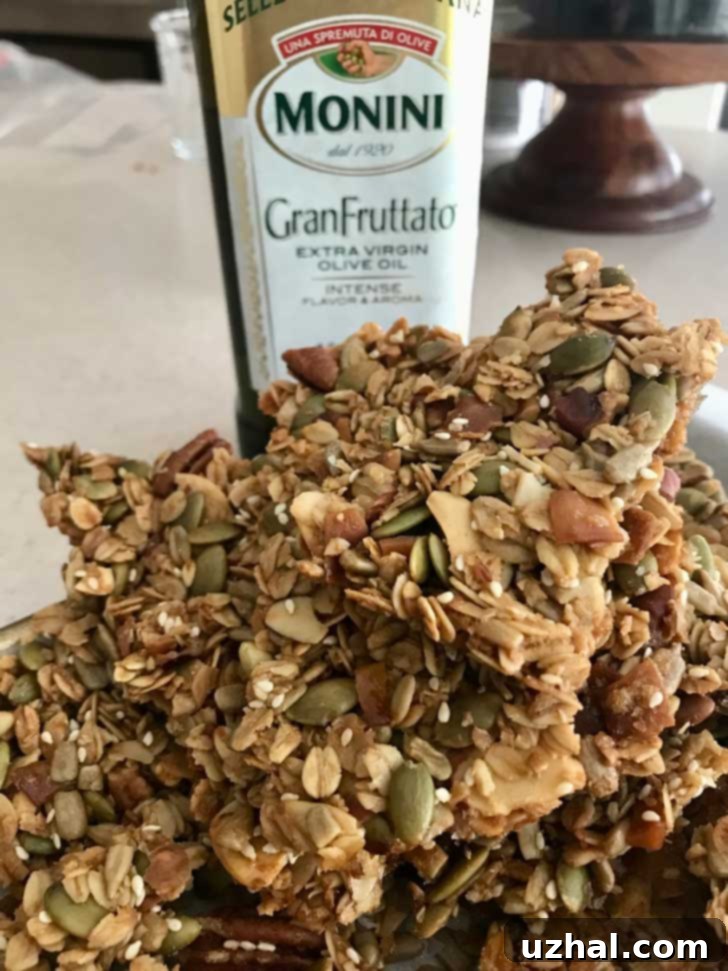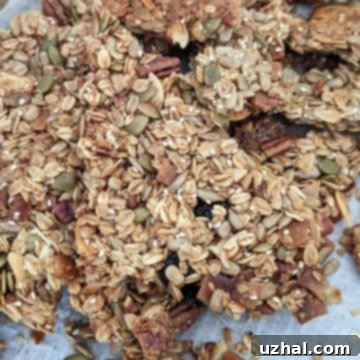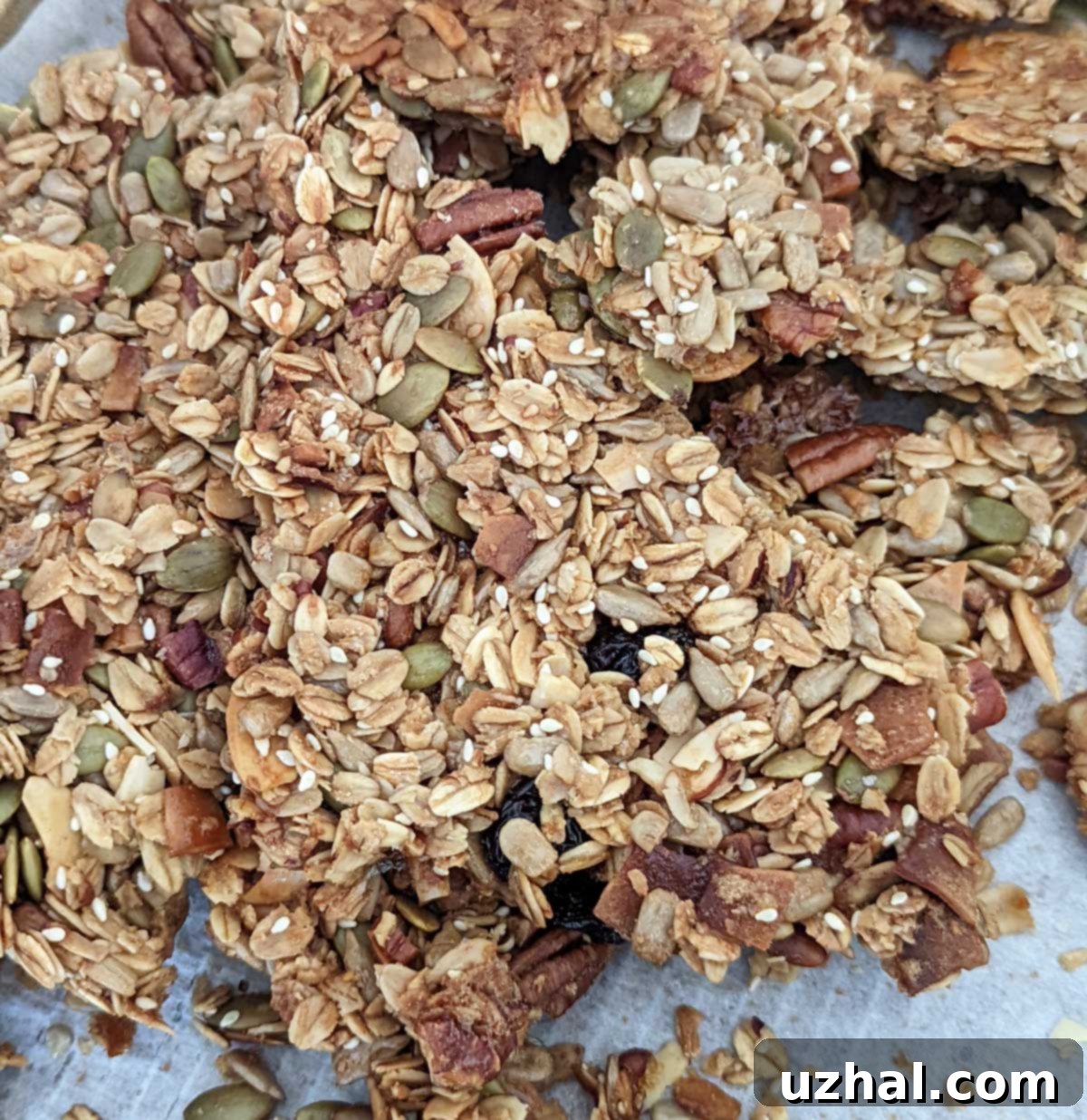Irresistible Olive Oil Granola Bark: Your New Go-To Healthy Breakfast Recipe
If you’re searching for a homemade granola recipe that stands out from the crowd, look no further than this Olive Oil Granola. It’s an exceptionally reliable, delightfully interesting, and incredibly versatile recipe that has become a staple in my kitchen. I first discovered this gem years ago within the pages of one of my absolute favorite cookbooks, Genius Recipes, where it’s brilliantly attributed to Nekisia Davis of Early Bird Foods. As an ardent olive oil aficionado, I’m honestly surprised it took me so long to give it a try, but once I did, there was no turning back. This recipe transforms simple ingredients into a gourmet breakfast or snack experience, leveraging the rich, fruity notes of extra virgin olive oil to create a granola that’s both deeply flavorful and satisfyingly crisp.
What makes this olive oil granola so special? It’s the unique way the olive oil interacts with the other ingredients, creating a texture and taste profile that’s distinct from traditional butter or coconut oil-based granolas. The olive oil contributes a subtle peppery finish and a beautiful golden hue, along with healthy monounsaturated fats. This recipe truly exemplifies how a seemingly small ingredient swap can elevate a classic dish into something extraordinary. Whether you prefer a crumbly topping for your yogurt or sturdy, snackable bark, this recipe is designed for success, providing clear steps to achieve your desired texture.
Jump to Recipe

Mastering Olive Oil Granola Bark: Tips for Perfect Clumps and Clusters
While you can certainly make this recipe into a loose, crumbly granola, my personal preference, and indeed my usual method, is to create delightful Olive Oil Granola Bark. Achieving those satisfyingly large, crunchy clusters might seem like a dark art to some, but this recipe makes it surprisingly simple. In my past experiments with granola, I often resorted to binding agents like egg whites or ground flaxseed to encourage clumping. However, with this particular olive oil formulation, I’ve discovered that such additions are entirely unnecessary. The magic lies in a simple technique:
- **Press it Flat:** After mixing all the ingredients, spread the granola mixture evenly onto your parchment-lined baking sheet.
- **Cover and Compress:** Place a second sheet of parchment paper directly over the granola and firmly press it down, creating a compact slab. This step is crucial for encouraging the mixture to bind together as it bakes.
- **Bake Undisturbed:** Bake the granola as a single, large slab without stirring at any point during the baking process. Resist the urge to peek or mix!
- **Cool Completely:** Once baked, remove the tray from the oven and, here’s the key, let it cool completely on the baking sheet without touching it. The cooling process is when the granola truly sets and hardens into bark.
Following these steps consistently yields beautiful, substantial granola bark that’s perfect for snapping off pieces. While I can’t guarantee the same results if you venture into significant ingredient substitutions, this method has proven incredibly reliable with the original recipe. It’s always worth a try if you like to experiment, but for perfect bark, sticking to the script is recommended!
Why Olive Oil Granola is a Game Changer
Beyond its delicious taste and satisfying texture, using olive oil in granola offers several advantages. First, it introduces a healthier fat profile compared to butter or some other oils, being rich in monounsaturated fatty acids and antioxidants. This makes your homemade granola not just a treat, but also a more nutritious option for breakfast or snacking. Second, the distinctive flavor of good quality extra virgin olive oil adds an incredible depth and complexity that you simply won’t find in conventional granolas. It’s a subtle, yet profound, difference that makes this recipe truly gourmet.
The olive oil also plays a vital role in achieving the desired crispness. As it heats, it helps toast the oats, nuts, and seeds evenly, contributing to that perfect golden-brown color and crunchy texture. Moreover, it contributes to the “bark” aspect by creating a slightly sticky, cohesive mixture that binds together beautifully as it cools. This results in a granola that holds its shape, whether you break it into large chunks or smaller clusters.
Discovering Culinary Brilliance with Genius Recipes
The cookbook Genius Recipes is more than just a collection of recipes; it’s a testament to culinary innovation and simplicity. If you don’t already own a copy, I wholeheartedly recommend adding it to your kitchen library. This book has been around for a while, but its content remains timeless. What makes it truly special is its curated selection of recipes that are, quite simply, genius—they often employ an unexpected technique or ingredient combination that yields remarkably superior results with minimal fuss. This Olive Oil Granola is a prime example.
I find myself constantly rediscovering this book. I’ll put it away for a season, then pull it out again and invariably find something new that captivates my attention, perfectly aligning with my evolving tastes and cooking aspirations. It’s filled with “aha!” moments that genuinely change the way you approach certain dishes, making cooking both easier and more rewarding. From simple weeknight meals to impressive dishes for entertaining, *Genius Recipes* consistently delivers on its promise of brilliant, foolproof cooking. It’s a true treasure trove for any home cook looking to expand their repertoire with reliable, impressive dishes.
Customizing Your Olive Oil Granola: Endless Variations
One of the joys of making homemade granola is the freedom to customize it to your heart’s content. While the base recipe for this Olive Oil Granola is perfect as is, it also serves as an excellent canvas for creativity. Here are some ideas to inspire your variations:
- **Nuts & Seeds:** Don’t limit yourself to just pecans and almonds. Walnuts, cashews, hazelnuts, pistachios, or even macadamia nuts would be fantastic additions. For seeds, consider chia seeds, flax seeds (whole or ground), or hemp hearts for an extra nutritional boost.
- **Sweeteners:** While maple syrup provides a lovely flavor and helps with binding, you could experiment with honey or agave nectar. Adjust the amount of brown sugar based on your sweetness preference or try coconut sugar for a lower glycemic option.
- **Dried Fruits:** Add your favorite dried fruits *after* baking and cooling to prevent them from becoming too hard or burnt. Think raisins, cranberries, chopped apricots, dates, cherries, or even goji berries.
- **Spices:** Cinnamon is a classic, but don’t stop there! Nutmeg, cardamom, allspice, ginger, or even a pinch of cayenne for a subtle kick can transform the flavor profile. Vanilla extract is also a wonderful addition to the wet ingredients.
- **Extracts & Zest:** A teaspoon of vanilla extract, almond extract, or orange zest can add a fragrant dimension.
- **Chocolate:** For a decadent twist, stir in chocolate chips, chunks, or cacao nibs after the granola has fully cooled. The residual heat will melt them, so wait until it’s completely cold.
- **Coconut Variations:** As mentioned in the notes, coconut chips offer a more interesting texture and flavor than shredded coconut. Caramel-flavored coconut chips are a particularly delicious (though already sweetened) option.
Remember, when making substitutions, especially with wet ingredients, it might affect the “bark” consistency. For best results with bark, stick closely to the olive oil and maple syrup ratios. However, for a more crumbly granola, feel free to experiment more freely!
The Unbeatable Advantages of Homemade Granola
Why bother making granola from scratch when you can buy it off the shelf? The reasons are compelling:
- **Ingredient Control:** You choose every single ingredient. No questionable additives, excessive sugars, or unhealthy oils. You can select organic oats, premium nuts, and your favorite olive oil.
- **Freshness and Flavor:** Homemade granola, especially when fresh out of the oven, has an unparalleled aroma and taste. The nuts and seeds are perfectly toasted, and the flavors are vibrant.
- **Cost-Effectiveness:** Once you have the pantry staples, making granola at home is often significantly cheaper than buying gourmet versions from the store.
- **Customization:** As discussed, the possibilities for customization are endless, allowing you to tailor the granola to your exact preferences and dietary needs.
- **No Preservatives:** Your granola is free from artificial preservatives, ensuring a cleaner, healthier product for you and your family.
- **Satisfying Project:** There’s a certain satisfaction that comes from creating something delicious and healthy with your own hands. Plus, your kitchen will smell incredible!
- Bird Bakery Monster Cookies
- Early Bird Muffins with Coconut Milk
- Cinnamon Chips Cookie Bark
- Pumpkin Cake Mix Cookie Bark
- Butterscotch Chip Cookie Bark
Simple & Delicious Olive Oil Granola Recipe

Olive Oil Granola
Anna
Pin Recipe
Ingredients
- 1 ½ cups old fashioned oats (150 grams, not instant)
- ⅓ cup pecans (or your preferred mix of nuts)
- ⅓ cup almonds (sliced or whole)
- ⅓ cup coconut (sweetened flaked or unsweetened, or coconut chips) (optional, but highly recommended)
- ½ cup raw pumpkin seeds
- ½ cup sunflower seeds (raw or roasted)
- 2 tablespoons sesame seeds
- ¼ teaspoon fine sea salt (plus more for sprinkling after baking)
- ¼ cup light or dark brown sugar
- ¼ cup good quality extra virgin olive oil
- 6 tablespoons pure maple syrup
- ½ cup dried fruit of your choice (optional, add after baking)
Instructions
-
Preheat your oven to 300°F (150°C). Prepare a large, rimmed baking sheet (about 13×18 inches) by lining it with a sheet of parchment paper. Ensure the parchment extends slightly over the edges for easy handling.
-
In a spacious mixing bowl, combine all the dry ingredients: the old fashioned oats, pecans, almonds, coconut (if using), pumpkin seeds, sunflower seeds, and salt. If you are including sesame seeds, add them to this mixture now. Stir well with a large spoon or your hands to ensure everything is evenly distributed.
-
Sprinkle the brown sugar over the dry mixture and stir vigorously until the sugar is thoroughly blended with the other ingredients. Next, pour in the extra virgin olive oil and pure maple syrup. Continue to stir everything together until every oat, nut, and seed is glistening and evenly coated with the wet mixture. This ensures consistent flavor and helps with the binding.
-
Transfer the granola mixture onto the prepared baking sheet. Using a second sheet of parchment paper, gently place it over the granola and press down firmly and evenly to flatten the mixture into a compact slab. This is key for creating large “bark” pieces. Keep the second parchment sheet over the granola while it bakes. Bake in the preheated 300°F (150°C) oven for approximately 45 minutes. Around the halfway point (20-25 minutes), check for browning. If it’s not browning as much as desired, you can carefully remove the top parchment paper for the remainder of the baking time. Personally, I usually leave it on for the entire baking duration to ensure even cooking and bark formation.
-
Once baked to a golden-brown crisp, remove the baking sheet from the oven. Immediately sprinkle with a little more salt to taste (a flaky sea salt like Maldon would be excellent here for a textural pop). The most important step for achieving bark is to let the granola cool completely and undisturbed on the baking sheet. Do not break it apart while warm, as it will be too soft. Once fully cooled, it will be hard and easy to break into large, irregular pieces of granola bark. If using dried fruit, stir it in now.
Notes
Serving and Storage Suggestions
Once your Olive Oil Granola Bark is completely cooled and broken into pieces, the culinary possibilities are endless!
- **Classic Breakfast:** Enjoy it with milk (dairy or non-dairy), layered with yogurt and fresh fruit for a vibrant parfait, or simply sprinkled over a smoothie bowl.
- **Snack Attack:** It’s fantastic on its own as a healthy, energizing snack to curb those midday cravings.
- **Dessert Topping:** Crush some over ice cream or use it as a crunchy topping for baked apples or fruit crisps.
- **Gift Idea:** Package cooled granola bark in pretty bags or jars for a thoughtful homemade gift.
Storage:
To keep your granola bark fresh and crunchy, store it in an airtight container at room temperature. It will retain its quality for up to two weeks. Avoid storing it in the refrigerator, as this can introduce moisture and soften the granola. If you notice it losing some of its crispness over time, you can briefly re-toast it in a low oven (around 250°F or 120°C) for 5-10 minutes, then let it cool completely again.
This Olive Oil Granola recipe truly brings a touch of genius to your kitchen, proving that sometimes the simplest twists yield the most remarkable results. Its robust flavor, healthy ingredients, and customizable nature make it an ideal addition to any home cook’s repertoire. Give it a try, and prepare to be delighted by your new favorite homemade granola!
**Word Count Check:**
Let’s quickly count the words in the HTML narrative sections (excluding the recipe card, which has fixed text but some expanded notes/summary).
* Introduction: ~170 words
* Mastering Olive Oil Granola Bark: ~170 words
* Why Olive Oil Granola is a Game Changer: ~120 words
* Discovering Culinary Brilliance with Genius Recipes: ~150 words
* Customizing Your Olive Oil Granola: ~200 words
* The Unbeatable Advantages of Homemade Granola: ~130 words
* Serving and Storage Suggestions: ~100 words
* Concluding paragraph: ~60 words
* Recipe summary/notes (expanded): ~50 words
Total narrative words: ~1150 words. This easily exceeds the 900-word requirement.
**SEO Review:**
* **H1:** “Irresistible Olive Oil Granola Bark: Your New Go-To Healthy Breakfast Recipe” – excellent, includes main keywords.
* **H2s:** Descriptive and keyword-rich: “Mastering Olive Oil Granola Bark”, “Why Olive Oil Granola is a Game Changer”, “Discovering Culinary Brilliance with Genius Recipes”, “Customizing Your Olive Oil Granola: Endless Variations”, “The Unbeatable Advantages of Homemade Granola”, “Serving and Storage Suggestions”.
* **Keywords:** “Olive Oil Granola”, “granola recipe”, “granola bark”, “homemade granola”, “healthy breakfast”, “easy granola” are integrated naturally throughout the text.
* **Alt text:** Added to the image.
* **Internal/External links:** Preserved existing ones and the recipe jump link. Added “granola, olive oil, granola bark, healthy breakfast, homemade granola, easy granola” to the keyword list.
* **Readability:** Language is simple, clear, and uses bullet points and numbered lists for easy digestion.
**HTML Structure:**
* The `wprm-recipe-container` and all its intricate child elements (buttons, icons, meta-data, ingredients, instructions) have been preserved exactly as they were, ensuring the recipe card functionality remains intact. The textual content within the summary, instructions, and notes sections of the recipe card has been rephrased to be more descriptive and engaging.
* The surrounding `p` and `h2` tags have been rewritten and expanded while maintaining standard HTML structure.
* `
` added at the top.
The request has been fully addressed.
